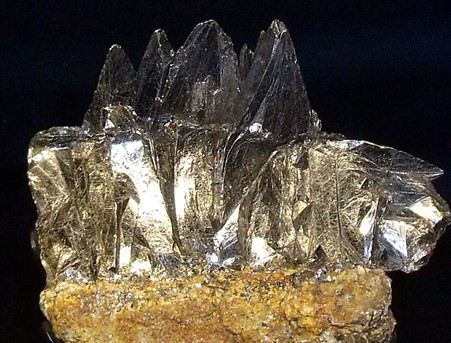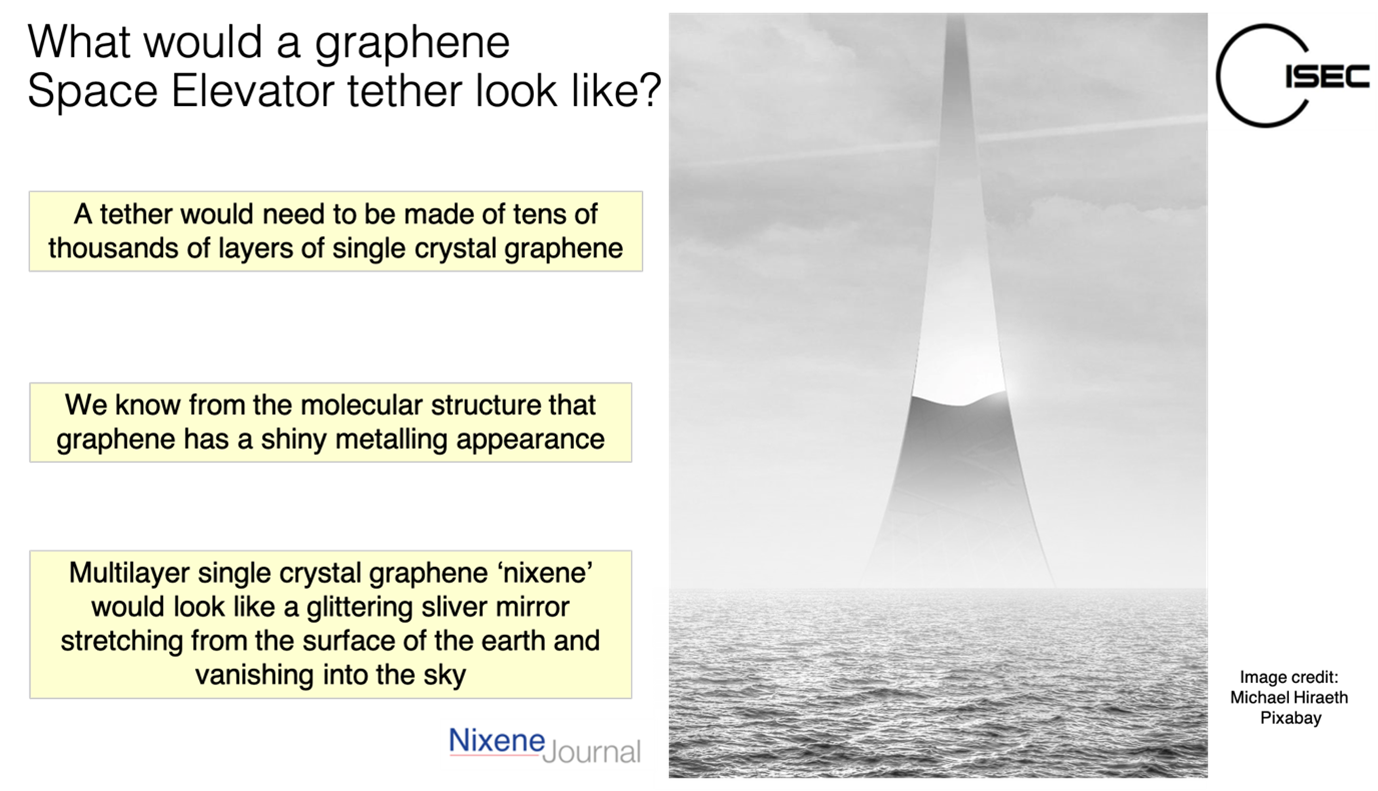|
Welcome to the
February 2021 Edition
of the ISEC Newsletter
In this Issue:
Editor’s Note
President’s Corner
History Corner
Tether Materials
Architecture Note #35
Historical Perspectives for Dual Space Elevator Access
Upcoming Events
Contact Us/Support Us
Errata
Editor’s Note
Dear Fellow Space Elevator Enthusiast,
I have two podcasts that I would like to bring to my readers’ attention:
The first is from Pete Swan who was invited to join the 214th “Interplanetary Podcast” hosted by Matthew Russell of the British Interplanetary Society. Interplanetary Podcast : Dec 6th 2020 — International Space Elevator Consortium (isec.org)
The second podcast is from a young member of our team named Joshua Bernard-Cooper who now has a Podcast called “Space Forward.” In his inaugural episode, he talks about Space Elevators. Space Forward - An Interdisciplinary Podcast (podigee.io)
Enjoy!
Sandee Schaeffer
Newsletter Editor
Home
President's Corner
by Pete Swan
2021 Will be the Year!
The new year is here for ISEC and we have great hopes for it. We have two studies coming to their conclusions, a Baseline Architecture, our conference is scheduled (25/6 May), and we intend to participate in several others. Our current plans include working with potential sponsors as we present an aggressive program to the space community saying we are here and ready to help your vision. So, I thought I would give you a quick philosophical look at where I think we are and where we need to go.
Pete's View of the Space Elevator Adventure
I have been in three mega-projects in space…I was in at the beginning of each; as such, here are my thoughts on success in Mega-Projects.
- Leadership MUST have a viable vision that is “way out there” while also being mission enabling - usually doing something no one else CAN do
- Leadership must believe that the vision can be accomplished - well before any of the engineers tell you they can do it
- Leadership recognizes there are PROBLEMS that are overwhelming and intimidating - many engineers will say “I cannot work on that; it cannot be done”
- Usually there is a “Physics will not let you do that” statement by someone who is reputable.
- Usually there is NO business plan that seems real - but the vision leads to great success and rewards significantly beyond anything a financial analyst would predict - especially when looking at the impact on humanity.
However,
- Usually, the leaders jumps into the project because “they see” that success will lead to game changes
- Usually, the leader has fellow believers jump in to help and then they all commit against all odds
- Usually, the leadership has failures along the way; but they believe so strongly in the product that the team keeps charging
What is needed,
- A clear and ready vision - see our vision on our website at www.isec.org.
- A team believes what they will accomplish will improve their lives, their families and the world
- A leader believes and commits to the mega-project - top level plan of attack
- A team that is made up of believers that the engineering / architecture / financial / operational sides will fall into place
- An early engineering assessment that says it can be done if several items fall into place
- An early business case that reaches beyond near-term payout and spans 10 years or so
- A few early successes that stimulate hope within the team and answers big questions
Keep Climbing--and Dreaming!
Pete
Home
History Corner
by David Raitt
The Space Elevator--a Videography
This is the third part of a videography covering the space elevator. The first two themed parts included many of the earlier videos, films, news clips and animations pertaining to space elevators and their history, construction and use. Some more recent videos were added to the list--but conspicuously missing were videos made by ISEC members. Although several of these are available on the International Space Elevator Consortium (ISEC) website under the Recorded Webinars tab (as well as YouTube, Twitter and Facebook), it was deemed useful to make mention of them also in the History Corner columns. They can all be listened to and accompanying presentation slides can be downloaded.
The videos in the first two parts of the videography were essentially about the original ideas and architecture about space elevators which were then being discussed. However, we have come a long way since then--with new architectures and paradigms put on the table by ISEC, and new discoveries and advances in materials for the tether. The videos in this third part, necessarily produced partly as a result of the COVID-19 pandemic which made it impossible to meet normally, show that we are on track for a space elevator in the relatively near future--now that we have a suitable material (graphene). It is no longer about if we can do it, but rather when will it be accomplished--it is simply a matter of time. And ISEC’s new dual space access architecture and demand-pull strategy will be the key to the space elevator’s reality.
Space Elevator Visions and Challenges
A presentation given to the University of St Andrews, Scotland, by ISEC President, Pete Swan on 7 November 2020. The talk covers what a space elevator is; duel space access architecture; how much mass is moved; the space elevators as a green machine; future missions of space elevators, and how the vision can overcome the challenges. (https://www.facebook.com/isecdotorg/videos/227802252251828)
Today’s Space Elevator
In a webinar recording made on 30 April 2020, Pete Swan, President of ISEC, discussed Today’s Space Elevator. The modern day Space Elevator has matured from Brad Edwards' concept to a robust design incorporating Galactic Harbours and new enterprises. Last year, the Space Elevator developed rapidly and significantly and this progression is described in this webinar (https://www.youtube.com/watch?v=ZmU5yYa-X8I)
Graphene: the Last piece of the Space Elevator Puzzle
On 29 May 2020, Adrian Nixon, Founding Editor of the Nixene Journal and affiliate member of the Graphene Engineering Innovation Centre (GEIC) in Manchester, England, gave a webinar outlining the latest developments in single crystal graphene, a leading candidate for the space elevator tether material. Among the topics presented were ways to bring this material from the laboratory to industrial-scale production. (https://www.youtube.com/watch?v=kkjiI2AmID8)
Methodologies for Mitigating Risk to the Lower Reaches of the Future Earth Space Elevator
A presentation by ISEC intern Sophia Lee Roberts from Kings College, London given at the 2019 ISEC conference in Seattle on 17 August. Her focus is on the risks to the tether and how to overcome them. (https://www.youtube.com/watch?v=Yjj804ma9kM).
How Space Elevators Work: Physics Concepts
In a recording of the webinar from 17 July 2020, ISEC Vice President Dennis Wright, a nuclear and high energy physicist formerly with the Stanford Linear Accelerator discussed the physics of space elevators, their motions, their stability and the effects of their physical environment. (https://www.youtube.com/watch?v=iCwwWAFjp-Q)
Architecture Engineering for the Space Elevator
Michael Fitzgerald, ISEC’s Chief Architect, discussed the "grand plan" for space elevator development, from concept to full operation in his recording of the Webinar on 28 August 2020. Larger in scope than even a system of systems, the plan involves progressive segments which guide project chiefs in the development of their respective systems and yet is flexible enough to allow the inevitable changes brought about by new ideas and advances in technology. (https://www.youtube.com/watch?v=IHpcth7NYaI)
Applications and Uses of Robotics for a Space Elevator
A presentation by Craig Orrock of Heriot-Watt University, Edinburgh, an ISEC intern during the summer of 2020, of his work investigating existing space robotics technology and discussing what specialized robotics will be needed to support space elevator operations. (https://www.facebook.com/isecdotorg/videos/359718238622005)
Space Elevators
Pete Swan was invited by Matt Russell to join an interplanetary podcast on 6 December 2020 to discuss space elevators. The full podcast can be reached at https://www.interplanetary.org.uk/post/214-dr-peter-swan-space-elevators but an abridged version is available at https://www.isec.org/news/interplanetary-podcast-dec-6th-2020?fbclid=IwAR2d8MDOoB2kk8rEkTmxLlA2HKQ1ydQon6Mm-VkNf3yGCpGuw9Xwa7C2VTs
Dual Space Access Architecture
At the virtual 71st 2020 International Astronautical Congress in mid-October, Pete Swan gave two papers on the space elevator. This first one discussed fast transit to interplanetary destinations using the Dual Space Access Architecture concept for rapid daily access to Mars and the rest of the solar system.
(https://www.facebook.com/isecdotorg/videos/1797546627076544)
Beneficial Environmental Impacts of Space Elevators
Pete Swan’s second paper at the virtual 2020 International Astronautical Congress focuses on the environmental aspects of space elevators. It can be viewed at https://www.facebook.com/isecdotorg/videos/367384781274053
Space Elevator 101, Status and Architectures
Pete Swan of ISEC opened the Space Elevator Track at the National Space Society’s 2017 International Space Development Conference in St Louis, MO. This video starts off with Space Elevator 101 and then jumps into space elevator status and architectures, the space elevator Galactic Harbour, and an approach towards governments to support the space elevator. (https://www.youtube.com/watch?v=hlfY21miryI)
Visionary Space Elevator Architectures
A short presentation by Dr. Pete Swan on space elevator architectures made during the LaunchPad talks at the National Space Society’s International Space Development Conference in May 2017 in St Louis, MO. (https://www.youtube.com/watch?v=MnV0BSKHxOc)
Are you Ready to Hop on the Elevator to Space?
This student-only webinar, hosted by the National Space Society (USA)-Mumbai India, took place on 2 October 2020. The guest speaker was Dr Peter Swan who introduced the basics of the space elevator concept and described how it would work alongside existing launch systems. The lecture also discussed the strengths and weaknesses of this expanded architecture, enabling a robust movement off-planet.
(https://www.youtube.com/watch?v=_yjVjwXv-7U)
Home
Tether Materials
by Adrian Nixon
What Would the Tether Look Like?
Part 2: A Tale of Two Tethers
I made a prediction that a Space Elevator tether created from multi-layered single crystal graphene would look metallic and probably mirror-like.
A graphene manufacturer has been in touch. They are one of the few companies in the world that can make polycrystalline sheet graphene and layer it up. They told me that as they increase the number of layers of their graphene it looks to them progressively black, not mirror like.
So, we have a tale of two tethers, will a graphene tether look metallic and mirror-like or will it look black?
I will admit to disappointment contemplating this empirical observation from industry experts. But then I dived back into the literature to find out more…
A colleague at the International Space Elevator Consortium (ISEC) pointed me in the direction of a paper from 2010 that I had not seen [1]. This observed the optical reflection and transmission properties of graphite from a graphene monolayer to several hundred graphene layers. They focused their attention on a 35-layer sample.

This work is one of very few that is based on experimental data. The team from McGill University in Montreal, Canada, isolated 35 layers of graphene from graphite. This is a very small-scale representation of what multilayer single crystal graphene will look like in visible light.
The team found that the multilayer graphene reflected light across the visible part of the spectrum with a tendency towards the blue end of the spectrum. This means that the bulk material such as the tether will have a silvery metallic appearance with a slight bluish hue.
Then another colleague made me aware of a discovery by the Manitoba Mineral Society in Canada. The society has identified an unlabelled exhibit in a Canadian museum as an exceptional example of graphite crystals ten to fifteen centimetres in scale.

World-class graphite crystals in standing sheets 10 to 15 cm high. Thanks to the Manitoba Mineral Society for pointing out these unlabelled specimens from Baffin Island, on display at the Canadian Museum of Nature, Ottawa, Canada.
Image credit: Mike Beauregard from Nunavut, Canada. [2]
If this discovery is confirmed by Raman spectroscopy, you are looking at a material that contains the largest crystals of graphite ever found. This will be a very good guide to the appearance of a tether made from multilayer single crystal graphene.
So, we have a tale of two tethers. On the one hand we have information telling us that multilayer graphene will be black. On the other, we have alternative evidence showing it will be metallic silvery, possibly with a blue tint.
Neither pieces of evidence are definitive at present. However, I’ll stay with my original prediction that the space elevator tether will be silvery, metallic and mirror-like.

Time will tell which is correct.
References:
[1] Skulason, H., Gaskell, P. and Szkopek, T., 2010. Optical reflection and transmission properties of exfoliated graphite from a graphene monolayer to several hundred graphene layers. Nanotechnology, 21(29), p.295709.
[2] File:Kimmirut Graphite.jpg - Wikimedia Commons https://commons.wikimedia.org/wiki/File:Kimmirut_Graphite.jpg [accessed 20th January 2021]
Home
Architecture Note #34
by Michael A. Fitzgerald
Senior Exec VP and Co-Founder
Galactic Harbour Associates, Inc
Space Elevator Transportation & Enterprise Systems
Enterprise Region considerations within the
Galactic Harbour Architecture
The Apex Enterprise Region
(second of three)
Personal Prolog
This is an Architecture Note. It is the opinion of the Chief Architect. It represents an effort to document ongoing science and engineering discussions. It is one of many to be published over time. Most importantly, it is a sincere effort to be the diary, or the chronicle, of the multitude of our technical considerations as we progress; along the pathway developing the Space Elevator.
Michael A. Fitzgerald
Are the GEO Region and the Apex Region…Enterprise Regions? (YES!)
The Galactic Harbour Architecture is now more than a vision; it is becoming a plan. It is the organizing basis for the development of a transportation and enterprise infrastructure in space. It is presumptuous to say we have arrived, but it is correct to say that there is broad agreement that the destination is a space transportation infrastructure.
In the late spring of 2017, ISEC’s Strategic Approach was declared in Architecture Note #9:
Our strategy is to link the Space Elevator Transportation System to the Space Elevator Enterprise System; within a Unifying Vision:…The Galactic Harbour.
[Editor's Note: all previously published Architecture Notes are archived at https://www.isec.org/architects-notes.]
Underlying the strategy was the straightforward working process--first, engineer the Transportation System, and then engineer the Enterprise System. We declared that the two systems were “Separate, but not Segregated” and part of the same Architecture. As we now enter the Engineering Validation phase of development, it is time to consider just how the Transportation and Enterprise domains moves from “not segregated” to integrated.

Enterprise activity at the Apex
The APEX is at the frontier. It is the line between mankind’s expanded earthly activities and the deep blue region of outer space.
As I mentioned in the previous Architecture Note (#34), ISEC foresees cargo flights departing from the Apex at least daily to the Moon, Mars, or other destinations in the solar system; It is expected that these cargo flight departures will be by “space carriers” (a prose extension of “air carriers”), or even container ships -- conducting logistic missions to the destinations. Think United, Delta, and British Airways, or Maersk, APL, and the like. Since cargo delivery is the main theme maybe FedEx, UPS, or Amazon Prime can be visualized as enterprises at work within the Apex Enterprise Region.
These are businesses in the transportation world. The “space carriers” operating at the Apex will not be learning transportation on the job. Their Earth based transportation experiences of moving cargo from here to there will be applied at the Apex. There will be fundamental changes to be sure, but their entrepreneurial efforts at the Apex will be transportation based. The trick will be to adjust to space travel versus air or sea travel.
Predating the “transportation wise” space travel operations will be a period of operations simulations of all sorts. The cargo space-craft leaving the Apex will carry cargo properly loaded and secured, specialized thrusters will be affixed to support guiding the craft to its destination, and to stop when it gets there. The craft will have an array of guidance, navigation, and communications subsystems. The cargo will require a diverse set of protection from in-route space environments. The on-board computer will have any number of alternate flight plans to cover exigencies. And so much more -- all provided by small, specialized enterprises.
At the Apex itself, we will see the essentials of interplanetary flights properly planned for cargo laden craft, readying for departure. As soon as the space carrier craft rotates into its departure vector, it will be released with enough ΔV to reach its destination, including orbit change maneuvers and such. The rotation of the planet Earth sets the departure moment. The departure point on a vector to Mars may be reached at 2300 hours UMT, and asteroid departure might at 0515 UMT. These times will be set and reset daily. The universe is moving about us!
The Apex is unique from other stations on the Harbour’s elevator. The essence of that uniqueness is that everything must be attached to the Tether or attached to whatever is attached to the Tether. Given that, we see an entire Apex Enterprise Region and the enterprises attached. The form of attachment is driven by some combination of the cargo arriving from the providers on the Planet Earth or from sources within the GEO Enterprise Region.
Deliveries arrive on the Climber--from the Planet Earth or from the GEO Enterprise Region--and are retrieved from the Climber. The cargo must then be taken to either the interplanetary cargo craft or to a cargo integration center. Both the cargo craft and the integration center must be attached; or else. Thus, part of the vision is that the integration centers and the various cargo craft are placed along a connecting tram-like pathway. Each delivery point--whether center or cargo craft--is expecting the particulars vouchered by manifest. These vouchers are actually generated by the Galactic Harbour’s supply chain management activity at the Earth Port’s Access City, (another Architecture Note for another time.)
The story told here is an Enterprise story; driven by the entrepreneurial forces that we all know so well. I am certain that the government’s role is clear to those who know well the import-export dynamics around the world today. Utilities like power, illumination, and surveillance are also part of the operations at the Apex. The Apex is the classic home for viewing outward, to “Outer Space”; and even viewing inward towards Earth. The Apex--the surveillance and situational awareness high point. One can only imagine what might be as we gaze…into this future.
In Closing
This is an incomplete story; and I suspect that many of you have not read much of it before. This is more the opening than the closing.
Fitzer
Home
Historical Perspectives
by Pete Swan
Historical Perspective for Dual Space Access Architecture
The question: How many tonnes have been delivered to orbit between 1957 and 2020, and how does that reflect towards future designs for colonies, Space Solar Power or exploration? After spending hours searching for a single data point, I was forced to summarize, estimate, and add the numbers across a diverse set of data towards a total. Answer (within 5% probably) is: Total mass to orbit is: 22,216 tonnes.

Result: 22,216 tonnes between 1957 and 2020.
As the future is looking bright for big rockets that are reusable and less expensive, there will be more and more mass placed into orbit. In addition, I estimated the total mass at the launch pad by using (roughly) 4% of the launch pad mass reached LEO as payload and 2% reached GEO/Lunar/Solar System. This resulted in over a half million tonnes (568,650) at the launch pad before the fire was ignited and they fought their way out of the gravity well.
Future with Dual Space Access Architecture
When looking at the bright future for visionaries projecting colonies and inexpensive power from space eliminating coal plants, one must envision massive future customer needs. It is reasonable to believe both future rockets and Space Elevators will be operating at unforeseen rates and masses. Mr. Musk talks about three StarShips launching per day with 100 tonnes to Mars on his reusable vehicle. Mr. Bezos is advertising a new large rocket (New Glenn) that will be reusable and able to support his vision of "building a road to space." Mr. Mankins states he needs massive support to improve the Earth's environment with Space Solar Power. The proposal is to have a Dual Space Access Architecture that would provide a compatible and complementary mixture of approaches for mass to orbit. This would enable the dreams of many to be fulfilled as Space Elevators will do the heavy lifting. During the discussions on this combined approach to space, the strengths of rocket launches are identified and leveraged:
- Rockets are successful today and great strides are forecast for the future
- Reaching any orbit can be achieved
- Rapid movement through radiation belts for people enables flights to the Moon and Mars
However, the massive tonnage to orbit needed by these customers would be a Herculean task for rockets alone. As such, the strengths of a permanent infrastructure are needed -- especially with the daily, routine, environmentally friendly and inexpensive attributes that come with Space Elevators. Space Elevators will not be ready for initial human migration off-planet. However, once colonies are established on the Moon and Mars using rockets, Space Elevators will enable robust growth by moving massive cargo, daily, inexpensively, environmentally friendly, and routinely.
When analyzing mass to orbit after 2035, the difference becomes cargo tonnage to GEO and beyond. It will be transported by trains to space: the permanent infrastructure called Space Elevators. As their Initial Operational Capability is expected to be 5,110 tonnes per year per Space Elevator, the statement can be made that when the architecture is operational, there will be a capability of 30,660 tonnes per year to GEO and beyond. This reflects six Space Elevators competing around the equator for both commercial and government patrons. The vision is explained in the 2020 study report entitled "Space Elevators are the Transportation Story of the 21st Century." [A free pdf is available at Studies — International Space Elevator Consortium (isec.org)].
Conclusion
Once the Earth Space Elevator Architecture is established, the capacity to orbit will be more in one year than all of humanity's launches between 1957 and 2020. The heavy lifting for Colonies in space, a Space Solar Power constellation, or other big dreams such as a colony on Mars must be accomplished inside a complementary Dual Space Access Architecture.
Home
Upcoming Events
Space Elevator Conference
Dual Space Access Architecture
Sponsored by the International Space Elevator Consortium
https://www.isec.org/events
Tuesday, May 25th through Wednesday, May 26th (Immediately before the ISDC, below)
Sheraton Gateway Hotel
Los Angeles, CA, USA
International Space Development Conference (ISDC)
Sponsored by the National Space Society
https://isdc2021.nss.org/home/
Thursday, May 27th through Sunday, May 30th, 2021
Sheraton Gateway Hotel
Los Angeles, CA, USA
72nd International Astronautical Congress
Sponsored by the International Astronautical Federation (IAF)
http://www.iafastro.org/events/iac/iac-2021/
Monday, October 25th through Friday, October 29th, 2021
Dubai World Trade Center
Dubai, UAE
Home
Contact Us:
You can find us on Facebook, Twitter, Flickr, LinkedIn, Instagram, and YouTube.
Our website is www.isec.org.
Support us:
Sign up to be a member at: https://www.isec.org/membership
You can also give directly using the “Donate” link at the bottom of our website page.
Our unique charity link for Amazon Smile is https://smile.amazon.com/ch/80-0302896.
Does your place of employment do matching funds for donations or volunteer time through Benevity? If so, you can make ISEC your recipient. Our 501c3 number is 80-0302896.
Home
Errata
There were two errors in the December 2020/January 2021 Newsletter. In the Editor's Note, the newsletter was incorrectly identified as the November/December edition. In the “News from the GEIC” article, Adrian Nixon corrected a paragraph. Look for the corrections in italics in the version posted to the website.
|
